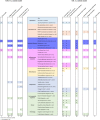Associations of environment, health history, T-zone lymphoma, and T-zone-like cells of undetermined significance: A case-control study of aged Golden Retrievers
- PMID: 30666722
- PMCID: PMC6430877
- DOI: 10.1111/jvim.15405
Associations of environment, health history, T-zone lymphoma, and T-zone-like cells of undetermined significance: A case-control study of aged Golden Retrievers
Abstract
Background: T-zone lymphoma (TZL), an indolent disease in older dogs, comprises approximately 12% of lymphomas in dogs. TZL cells exhibit an activated phenotype, indicating the disease may be antigen-driven. Prior research found that asymptomatic aged Golden Retrievers (GLDRs) commonly have populations of T-zone-like cells (phenotypically identical to TZL) of undetermined significance (TZUS).
Objective: To evaluate associations of inflammatory conditions, TZL and TZUS, using a case-control study of GLDRs.
Animals: TZL cases (n = 140), flow cytometrically diagnosed, were identified through Colorado State University's Clinical Immunology Laboratory. Non-TZL dogs, recruited through either a database of owners interested in research participation or the submitting clinics of TZL cases, were subsequently flow cytometrically classified as TZUS (n = 221) or control (n = 147).
Methods: Health history, signalment, environmental, and lifestyle factors were obtained from owner-completed questionnaires. Odds ratios (ORs) and 95% confidence intervals (95% CIs) were estimated using multivariable logistic regression, obtaining separate estimates for TZL and TZUS (versus controls).
Results: Hypothyroidism (OR, 0.3; 95% CI, 0.1-0.7), omega-3 supplementation (OR, 0.3; 95% CI, 0.1-0.6), and mange (OR, 5.5; 95% CI, 1.4-21.1) were significantly associated with TZL. Gastrointestinal disease (OR, 2.4; 95% CI, 0.98-5.8) had nonsignificantly increased TZL odds. Two shared associations for TZL and TZUS were identified: bladder infection or calculi (TZL OR, 3.5; 95% CI, 0.96-12.7; TZUS OR, 5.1; 95% CI, 1.9-13.7) and eye disease (TZL OR, 2.3; 95% CI, 0.97-5.2; TZUS OR, 1.9; 95% CI, 0.99-3.8).
Conclusions and clinical importance: These findings may elucidate pathways involved in TZUS risk and progression from TZUS to TZL. Further investigation into the protective association of omega-3 supplements is warranted.
Keywords: dog; epidemiology; lymphosarcoma; noninfectious diseases; oncology; statistical modeling.
© 2019 The Authors. Journal of Veterinary Internal Medicine published by Wiley Periodicals, Inc. on behalf of the American College of Veterinary Internal Medicine.
Conflict of interest statement
Julia D. Labadie had salary support from the National Science Foundation (Grant No. DGE‐1450032) and from the Morris Animal Foundation.
Figures




Similar articles
-
Genome-wide association analysis of canine T zone lymphoma identifies link to hypothyroidism and a shared association with mast-cell tumors.BMC Genomics. 2020 Jul 6;21(1):464. doi: 10.1186/s12864-020-06872-9. BMC Genomics. 2020. PMID: 32631225 Free PMC article.
-
Factors correlating with circulating T-zone-like cells of undetermined significance (TZUS) in dogs resident in Italy.Vet J. 2024 Jun;305:106143. doi: 10.1016/j.tvjl.2024.106143. Epub 2024 May 22. Vet J. 2024. PMID: 38788997
-
Canine T-zone lymphoma: unique immunophenotypic features, outcome, and population characteristics.J Vet Intern Med. 2014 May-Jun;28(3):878-86. doi: 10.1111/jvim.12343. Epub 2014 Mar 21. J Vet Intern Med. 2014. PMID: 24655022 Free PMC article.
-
T-zone lymphoma with cutaneous involvement: a case report and review of the literature.Br J Dermatol. 2002 Jun;146(6):1096-100. doi: 10.1046/j.1365-2133.2002.04699.x. Br J Dermatol. 2002. PMID: 12072087 Review.
-
[Demodicosis of dogs--a factorial disease?].Berl Munch Tierarztl Wochenschr. 1989 Sep 1;102(9):293-7. Berl Munch Tierarztl Wochenschr. 1989. PMID: 2679540 Review. German.
Cited by
-
Genome-wide association analysis of canine T zone lymphoma identifies link to hypothyroidism and a shared association with mast-cell tumors.BMC Genomics. 2020 Jul 6;21(1):464. doi: 10.1186/s12864-020-06872-9. BMC Genomics. 2020. PMID: 32631225 Free PMC article.
-
Factors affecting urinary organophosphate pesticide metabolite levels among Californian agricultural community members.Sci Total Environ. 2023 Jul 10;881:163362. doi: 10.1016/j.scitotenv.2023.163362. Epub 2023 Apr 12. Sci Total Environ. 2023. PMID: 37059148 Free PMC article.
-
The Genetic and Molecular Basis for Canine Models of Human Leukemia and Lymphoma.Front Oncol. 2020 Jan 24;10:23. doi: 10.3389/fonc.2020.00023. eCollection 2020. Front Oncol. 2020. PMID: 32038991 Free PMC article. Review.
-
Factors Associated with Levels of Organophosphate Pesticides in Household Dust in Agricultural Communities.Int J Environ Res Public Health. 2022 Jan 13;19(2):862. doi: 10.3390/ijerph19020862. Int J Environ Res Public Health. 2022. PMID: 35055689 Free PMC article.
References
-
- Valli VE, San Myint M, Barthel A, et al. Classification of canine malignant lymphomas according to the World Health Organization criteria. Vet Pathol. 2011;48:198‐211. - PubMed
-
- Flood‐Knapik KE, Durham AC, Gregor TP, Sánchez MD, Durney ME, Sorenmo KU. Clinical, histopathological and immunohistochemical characterization of canine indolent lymphoma. Vet Comp Oncol. 2013;11(4):272‐286. - PubMed
MeSH terms
Substances
LinkOut - more resources
Full Text Sources

